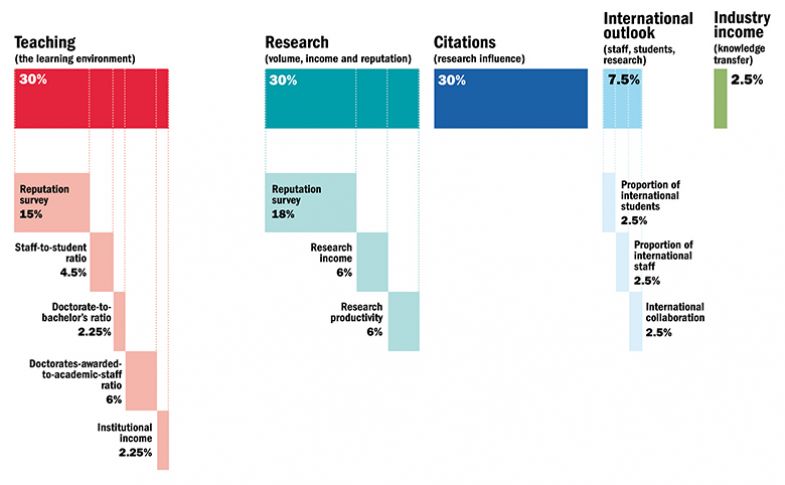Browse the full results of the World University Rankings 2019
The Times Higher Education World University Rankings are the only global performance tables that judge research-intensive universities across all their core missions: teaching, research, knowledge transfer and international outlook. We use 13 carefully calibrated performance indicators to provide the most comprehensive and balanced comparisons, trusted by students, academics, university leaders, industry and governments.
The performance indicators are grouped into five areas: teaching (the learning environment); research (volume, income and reputation); citations (research influence); international outlook (staff, students and research); and industry income (knowledge transfer).
Short on time? Here’s a video explaining our rankings methodology in less than two minutes.
Exclusions
Universities can be excluded from the World University Rankings if they do not teach undergraduates, or if their research output amounted to fewer than 1,000 relevant publications between 2013 and 2017 (with a minimum of 150 a year). Universities can also be excluded if 80 per cent or more of their research output is exclusively in one of our 11 subject areas.
Data collection
Institutions provide and sign off their institutional data for use in the rankings. On the rare occasions when a particular data point is not provided, we enter a conservative estimate for the affected metric. By doing this, we avoid penalising an institution too harshly with a “zero” value for data that it overlooks or does not provide, but we do not reward it for withholding them.
Getting to the final result
Moving from a series of specific data points to indicators, and finally to a total score for an institution, requires us to match values that represent fundamentally different data. To do this, we use a standardisation approach for each indicator, and then combine the indicators in the proportions indicated to the right.
The standardisation approach we use is based on the distribution of data within a particular indicator, where we calculate a cumulative probability function, and evaluate where a particular institution’s indicator sits within that function.
For all indicators except for the Academic Reputation Survey, we calculate the cumulative probability function using a version of Z-scoring. The distribution of the data in the Academic Reputation Survey requires us to add an exponential component.

Metrics
Teaching (the learning environment) – 30%
- Reputation survey: 15%
- Staff-to-student ratio: 4.5%
- Doctorate-to-bachelor’s ratio: 2.25%
- Doctorates-awarded-to-academic-staff ratio: 6%
- Institutional income: 2.25%
The most recent Academic Reputation Survey (run annually) that underpins this category was carried out between January and March 2018. It examined the perceived prestige of institutions in teaching. We have worked hard to ensure a balanced spread of responses across disciplines and countries. Where disciplines or countries were over- or under-represented, THE’s data team weighted the responses to more closely reflect the actual distribution of scholars (more details here). The 2018 data are combined with the results of the 2017 survey, giving more than 20,000 responses.
As well as giving a sense of how committed an institution is to nurturing the next generation of academics, a high proportion of postgraduate research students also suggests the provision of teaching at the highest level that is thus attractive to graduates and effective at developing them. This indicator is normalised to take account of a university’s unique subject mix, reflecting that the volume of doctoral awards varies by discipline.
Institutional income is scaled against academic staff numbers and normalised for purchasing-power parity (PPP). It indicates an institution’s general status and gives a broad sense of the infrastructure and facilities available to students and staff.
Research (volume, income and reputation) – 30%
- Reputation survey: 18%
- Research income: 6%
- Research productivity: 6%
The most prominent indicator in this category looks at a university’s reputation for research excellence among its peers, based on the responses to our annual Academic Reputation Survey (see above).
Research income is scaled against academic staff numbers and adjusted for purchasing-power parity (PPP). This is a controversial indicator because it can be influenced by national policy and economic circumstances. But income is crucial to the development of world-class research, and because much of it is subject to competition and judged by peer review, our experts suggested that it was a valid measure. This indicator is fully normalised to take account of each university’s distinct subject profile, reflecting the fact that research grants in science subjects are often bigger than those awarded for the highest-quality social science, arts and humanities research.
To measure productivity we count the number of publications published in the academic journals indexed by Elsevier’s Scopus database per scholar, scaled for institutional size and normalised for subject. This gives a sense of the university’s ability to get papers published in quality peer-reviewed journals. Last year, we devised a method to give credit for papers that are published in subjects where a university declares no staff.
Citations (research influence) – 30%
Our research influence indicator looks at universities’ role in spreading new knowledge and ideas.
We examine research influence by capturing the average number of times a university’s published work is cited by scholars globally. This year, our bibliometric data supplier Elsevier examined 67.9 million citations to 14.1 million journal articles, article reviews, conference proceedings, books and book chapters published over five years. The data include more than 25,000 academic journals indexed by Elsevier’s Scopus database and all indexed publications between 2013 and 2017. Citations to these publications made in the six years from 2013 to 2018 are also collected.
The citations help to show us how much each university is contributing to the sum of human knowledge: they tell us whose research has stood out, has been picked up and built on by other scholars and, most importantly, has been shared around the global scholarly community to expand the boundaries of our understanding, irrespective of discipline.
The data are normalised to reflect variations in citation volume between different subject areas. This means that institutions with high levels of research activity in subjects with traditionally high citation counts do not gain an unfair advantage.
We have blended equal measures of a country-adjusted and non-country-adjusted raw measure of citations scores.
In 2015-16, we excluded papers with more than 1,000 authors because they were having a disproportionate impact on the citation scores of a small number of universities. In 2016-17, we designed a method for reincorporating these papers. Working with Elsevier, we developed a fractional counting approach that ensures that all universities where academics are authors of these papers will receive at least 5 per cent of the value of the paper, and where those that provide the most contributors to the paper receive a proportionately larger contribution.
International outlook (staff, students, research) – 7.5%
- Proportion of international students: 2.5%
- Proportion of international staff: 2.5%
- International collaboration: 2.5%
The ability of a university to attract undergraduates, postgraduates and faculty from all over the planet is key to its success on the world stage.
In the third international indicator, we calculate the proportion of a university’s total research journal publications that have at least one international co-author and reward higher volumes. This indicator is normalised to account for a university’s subject mix and uses the same five-year window as the “Citations: research influence” category.
Industry income (knowledge transfer) – 2.5%
A university’s ability to help industry with innovations, inventions and consultancy has become a core mission of the contemporary global academy. This category seeks to capture such knowledge-transfer activity by looking at how much research income an institution earns from industry (adjusted for PPP), scaled against the number of academic staff it employs.
The category suggests the extent to which businesses are willing to pay for research and a university’s ability to attract funding in the commercial marketplace – useful indicators of institutional quality.
The calculation of the Times Higher Education World University Rankings 2019 has been independently audited by professional services firm PricewaterhouseCoopers (PwC), making these the only global university rankings to be subjected to full, independent scrutiny of this nature.
Read more about the PwC/Times Higher Education World University Rankings 2019 report.
Register to continue
Why register?
- Registration is free and only takes a moment
- Once registered, you can read 3 articles a month
- Sign up for our newsletter
Subscribe
Or subscribe for unlimited access to:
- Unlimited access to news, views, insights & reviews
- Digital editions
- Digital access to THE’s university and college rankings analysis
Already registered or a current subscriber?




